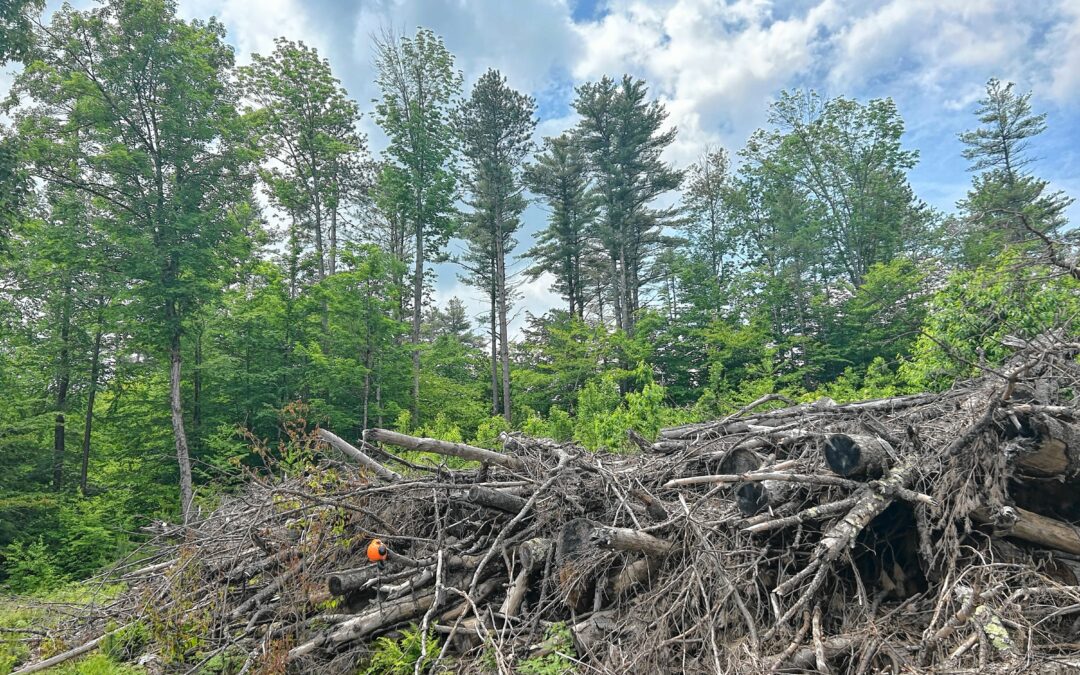Of all the problems that are plaguing New Hampshire’s forests these days, the cutest are the deer.
Those deep eyes! Those big ears! That flash of white tail as they bound through a field! Who doesn’t love them?
Anybody (like me) with a deer-ransacked garden, that’s who. And also foresters.
Deer are voracious browsers that can wipe out tree seedlings, altering the understory of Northeastern woods for the worse. In New Hampshire they take out young oak, sugar maple, and some other desirable hardwoods, leaving behind less biodiversity and more openings for invasive plant species.
Their expanding population is having serious impact. Consider what happens when deer-proof fencing is erected around a timber harvest site.
“In growing season 5, you might have something on the order of 18,000 tree stems per acre inside, compared to 11,000 tree stems per acre outside,” said Peter Smallidge, an extension forester at Cornell Uniformity in New York. The inside trees will also be taller, more diverse, and healthier.
But in this case, Smallidge isn’t talking about deer fences made of metal and plastic, which are expensive to build, hard to maintain and cause problems for other wildlife. He’s talking about slash walls.
“Slash” is the forestry term for the parts of trees that aren’t worth the expense of removing after a timber harvest: limbs, tree tops, small trees that got in the way. Hikers hate slash left in the forest, making it hard to walk, but wildlife likes it as cover and it’s good for the woods in other ways, such as conserving moisture and recirculating nutrients.
As the name implies, the idea of slash walls is to pile up this material to build walls that keep out the deer while the forest regenerates.
It’s a simple concept but not a trivial task. The walls need to be at least 10 feet tall because deer are great jumpers, so they must be around 20 feet wide at the base to remain stable. They also need to completely enclose an area because deer will find any gaps.
Research on slash walls has been percolating for a decade in New York, where deer populations are higher than in New England, as researchers and landowners experiment to see what works and what doesn’t. I learned about it from a recent article in the excellent “Northern Woodlands” magazine.
In New Hampshire, Steven Roberge, a forestry specialist and professor with UNH Cooperative Extension, oversaw the August 2020 construction of a small (half-acre enclosure) slash wall in Peterborough on land owned by the artists colony MacDowell. “I guess you’d call it a beta test,” he said.
He was enthusiastic about the result after a visit to the site on Monday.
“Outside of the wall … everything does have browse sign, with some white pine here and there. It’s knee height. Inside, we’re looking at trees that are probably 10, 12 feet tall including lots of pin cherry, which is very short-lived and very beneficial for wildlife, and soil chemistry. The hardwoods are about head height. No sign of browsing,” he said. “It is definitely serving its purpose.”
Slash walls aren’t perfect. They don’t work on steep slopes and they require a pretty dense forest. If a landowner has kept up with thinning a woodlot over the years, there may not be enough slash to work.
Still, Roberge said, “It’s pretty straightforwad if you have the machinery to do it … and the site is right. At the end of the day it’s the logging contractor who has to put it together.”
And they’re not a permanent fix. As the wood rots, the walls slump and after a decade or so, they’re no longer tall enough to keep out the deer. But that still makes a big difference, allowing seedlings to grow enough to survive browsing.
Researchers at Cornell have set up research enclosures, some as big as 70 acres in size. They’re developing best practices on construction, such as best diameter and length material to use and when to emphasize hardwoods over more brittle softwoods, and examining their effect on the ecosystem.
Prof. Paul Curtis at Cornell, for example, oversaw work in which game cameras were set up around slash walls to see the effect on wildlife.
“We found significantly more pictures of wildlife at, or near, the slash walls, which is not a great surprise. The diversity was pretty impressive; black bears, coyote, fisher, squirrels, red foxes,” he said.
And even the lack of permanence is something of a benefit since, unlike deer fencing, slash walls don’t need to be removed after they’ve served their purpose. “If done correctly, you do it once and they deteriorate on their own,” Curtis said.
Some questions remain, such as whether slash walls make wildfires worse or better, but overall this seems like an elegant way to reduce the damage done by nature’s most adorable disasters.
To learn more, check out Cornell’s Slash Wall Resource Center, at blogs.cornell.edu/slashwall.


 Return to the Concord Monitor
Return to the Concord Monitor
This sounds like a type of forest management that simply could not have been done until the invention of heavy machinery. Something new in the world.